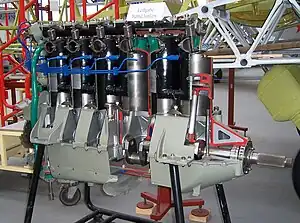Junkers L5
The Junkers L 5 was a six-cylinder, water-cooled, inline engine for aircraft built in Germany during the 1920s. First run in 1925, it was a much enlarged development of the Junkers L2.
| L5 | |
|---|---|
 | |
| Junkers L5 | |
| Type | Inline aircraft engine |
| Manufacturer | Junkers Motorenbau GmbH (Jumo) |
| First run | 1922[1] |
| Major applications | Junkers F.13 |
| Number built | >1,000[2] |
| Variants | Junkers L55 |
Design and development
The Junkers L5 was a development of Junkers' first water-cooled engine, the L2, but at four times the swept volume was a much more powerful engine. It was a water-cooled upright inline 6-cylinder unit, four-stroke and petrol-fuelled, with a capacity of nearly 23 litres. It adopted some of the L2 features, having twin exhaust and inlet valves in each cylinder[2]driven by an overhead camshaft, twin spark plugs and twin magnetos. The splash component of the L2's lubrication was abandoned in favour of a completely forced recirculating system. The twin carburettors of the L2 were replaced with a single float chamber, dual-venturi model. Like the L2, the L5 was a direct drive engine.[2]
The compression ratio of the standard version was 5.5:1, but variants had other ratios to cope with fuels with octane ratings between 76 and 95. The G series introduced carburettor heating together with an hydraulically damped mounting system. There were also choices of starting system, from inertial or compressed air systems to the traditional hand swinging.[2]
Operational history
The L5 proved to be reliable and became the engine of choice for most Junkers aircraft in the mid-1920s as well as powering aircraft from other German manufacturers.[2] Many of these powered the Junkers F.13 and its derivatives like the W 33, which dominated world air transport in the mid-1920s.[3]
The best demonstration of the reliability of the L5 was given by the unit which powered the single-engined W 33 Bremen in the first fixed wing east to west crossing of the Atlantic in April 1928. For this flight the compression ratio was raised to 7:1 to provide sufficient power for the heavily fuelled aircraft at take off. In July 1925 a W 33 powered by a L5 stayed aloft for 65 h 25 min, with a fuel consumption of 35.6 kg/h.[2]
Variants
- L5 many variants including a variety of compression ratios, power output levels and starting systems.
- L55 an upright V-12 built from two L5s on a common crankshaft.
- L8 a significant 1929 development with the same swept volume but cruising at 2,100 rpm and delivering 354 hp; take off power was 413 hp. The output was geared down at ratios between 2.47:1 and 1.44:1 to enhance propeller efficiency. Only a few were produced, powering early configurations of the Junkers G 38 as outer engines, with two L55s inboard.[2]
- L88 an upright V-12 built from two L8s on a common crankshaft.
Applications (L5)
Specifications (Jumo L 5)

Data from [2]
General characteristics
- Type: 6-cylinder liquid-cooled inline
- Bore: 160 mm (6.3 in)
- Stroke: 190 mm (7.5 in)
- Displacement: 22.92 L (1,399 cu in)
- Length: 1,750 mm (69 in)
- Width: 650 mm (26 in)
- Height: 1,265 mm (49.8 in)
- Dry weight: 334 kg (736 lb) dry
Components
- Valvetrain: Single exhaust and single inlet valves driven by a single overhead camshaft shaft and gear driven from the crankshaft
- Fuel system: Single float, dual venturi carburettor; twin plugs per cylinder, twin magnetos
- Fuel type: 95 octane (dependent on compression ratio)
- Oil system: forced
- Cooling system: liquid
Performance
- Power output: Take-off - 260 kW (350 hp) at 1,450 rpm
- Cruise - 210 kW (280 hp)
- Compression ratio: 7:1
- Fuel consumption: 61.6 kg/h (136 lb/hr)
- Power-to-weight ratio: 0.78 kW/kg (0.47 hp/lb)
References
- Gunston (2006), p. 112
- Kay (2004), pp. 264–265
- Kay (2004), p. 62